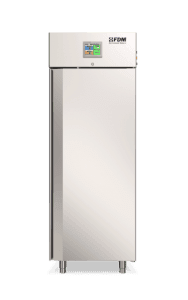
A large part of climatic tests involves raising the temperature and relative humidity to verify the reaction of the product or material to be tested.
But what about the other side of the climate spectrum?
What are refrigeration systems used for and how many types of cooling chambers are there?
Today we deal with this topic.
Types of Cooling Chambers
In the sector, a cooling chamber is an umbrella term that includes all those chambers that can bring and maintain the internal temperature at at least 0°.
For this reason, the function of a cooling chamber can be performed by at least three different types of laboratory instruments.
- b>Climatic Chambers and Environmental Chambers: climatic chambers and environmental chambers - which can also perform climatic tests that require very high temperatures - can also drop well beyond zero. However, they are more suitable for self-contained climatic tests, which are not the main function of the cooling chambers, as we will see.
- Laboratory refrigerators: specialized in reaching and maintaining the environment at very low temperatures, laboratory refrigerators perform the same function as cooling chambers and are often synonymous.
- Walk-In Cooling Chambers: the only case in which the term "cooling chamber" is used exclusively concerns those large chambers, called walk-ins, which are not comparable to a laboratory fridge.
Perform
Climate Stress
Discover the new series of Climate Chambers for controlled climate testing
Types of Refrigeration Systems
Cooling chambers work with two main cooling systems: expendable refrigerants and mechanical cooling systems. Let's see them in detail.
Expendable refrigerants, as the name suggests, involve the use of refrigerants that are used only once in the cooling process and subsequently discarded. The most common laboratory coolants are ice and liquid nitrogen. They are mainly used for single tests where cooling is only required for a limited period or where ease of use and safety are paramount.
Mechanical refrigeration systems, on the other hand, are more similar to those that use common household refrigerators. They are the most popular. The thermodynamic cycle involves a refrigerant fluid to remove heat from an environment and cool it. The major components of a mechanical refrigeration system include the compressor, condenser, evaporator and expander. The refrigerant is compressed, cooled, evaporated and then expanded to create the cooling cycle.
Uses of Cooling Chambers
The main use of cooling chambers is the storage of products and materials that need to be kept at very low temperatures.
There are three sectors most involved: food, pharmaceuticals and scientific research.
Walk-in cooling chambers are mostly used in the food sector to preserve a large number of products, while laboratory refrigerators, which are more practical and compact, are used in the pharmaceutical sector and in scientific research institutes.
The main international standard that regulates the matter is ISO 23953 which provides guidelines on classification, requirements and test conditions for countertop and non-professional refrigerators.
You cannot find the ideal chamber for your test?
Create your own environment, according to any test requirement
FDM Laboratory Refrigerators
FDM - Environment Makers offers a wide range of laboratory refrigerators and freezers capable of storing all the products and materials we have mentioned.
For further doubts and questions, please do not hesitate to contact us.
Would you like to receive a quote or do you have questions about the product?
Contact us to receive more information about this Product.



